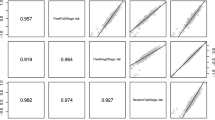Abstract
Computer simulations were conducted to determine whether conclusions obtained for the special case of a single stress and a single non-stress environment apply to the more general situation where a population of testing environments includes a range of stress and non-stress environments. Mean productivity, tolerance to environmental stress, and a regression coefficient stability parameter of genotypes across environments were compared to determine conditions under which these selection criteria should be used to improve yield across a range of contrasting environments. The results obtained from a worked example based on the single crosses from a 7 × 7 diallel cross in maize and the simulation experiment showed that the conclusions of Rosielle & Hamblin (1981) cannot be directly applied to a population of stress and non-stress environments. Selection for mean productivity should increase yield in both stress and non-stress environments unless the genetic variance in stress environments is more than double that in non-stress environments, and the genetic correlation between yields in contrasting environments is highly negative. Mean productivity and tolerance were shown to be positively correlated even if the genetic variance in stress environments is half that in non-stress environments. Genotypes with a high tolerance to stress were found to have low regression coefficient stability parameters, even when a range of stress and non-stress environments was used.
Similar content being viewed by others
References
Ceccarelli, S., S. Grando & J. Hamblin, 1992. Relationships between barley grain yield measured in low-and high-yielding environments. Euphytica 64: 49–58.
Cockerham, C.C., 1963. Estimation of genetic variance components. In: W.D. Hanson & H.F. Robinson (Eds.), Statistical Genetics and Plant Breeding, pp. 53–94. Natn Acad Sci Natn Res Council Publ.
Crossa, J., P.N. Fox & W.H. Pfeiffer, 1991. AMMI adjustment for statistical analysis of an international wheat yield trial. Theor Appl Gen 81: 27–37.
Digby, P.G.N., 1979. Modified joint regression analysis for incomplete variety × environment data. J Agric Sci Camb 93: 81–86.
Eberhart, S.A. & W.A. Russell, 1966. Stability parameters for comparing varieties. Crop Sci 6: 36–40.
Falconer, D.S., 1952. The problem of environment and selection. Am Nat 86: 293–298.
Falconer, D.S., 1989. Introduction to Quantitative Genetics. Longman Scientific and Technical, Hong Kong.
Falconer, D.S., 1990. Selection in different environments: effects on environmental sensitivity (reaction norm) and on mean performance. Genet Res Camb 56: 57–70.
Finlay, K.W. & G.N. Wilkinson, 1963. The analysis of adaptation in a plant breeding programme. Aust J Agr Res 14: 742–754.
Frey, K.J., 1964. Adaptation reaction of oat strains selected under stress and non-stress environmental conditions. Crop Sci 4: 55–58.
Gauch, H.G. & R.W. Zobel, 1988. Predictive and postdictive success of statistical analyses of yield trials. Theor Appl Gen 76: 1–10.
Genstat, 1996. Version 5, release 3.2. Lawes Agricultural Trust, Rothamsted Experimental Station.
Guei, R. & C.E. Wassom, 1992. Inheritance of some drought adaptive traits in maize. I. Interrelationships between yield, flowering and ears per plant. Maydica 37: 157–164.
Guei, R. & C.E. Wassom, 1993. Genetics of osmotic adjustment in breeding maize for drought tolerance. Heredity 71: 436–441.
Hallauer, A.R., 1988. Genotype-environment interaction. In: B.S. Weir, E.J. Eisen, M.M. Goodman & G. Namkoong (Eds.), Proc 2nd Int Conf Quantitative Genetics, pp. 488–490, Sunderland, Massachusetts. Sinauer and Associates.
Hildebrand, P.E., 1990. Modified stability analysis and on-farm research to breed specific adaptability for ecological diversity. In: M. Kang (Ed.), Genotype-by-Environment Interaction and Plant Breeding, pp. 169–180, Dept Agron, Louisiana Agric Expt Stn, Baton Rouge, USA.
Lambert, R.J., 1984. Reciprocal recurrent selection of maize in a high yield environment. Maydica 29: 419–430.
Lin, C.S., M.R. Binns & L.P. Lefkovitch, 1986. Stability analysis. Where do we stand? Crop Sci 26: 894–900.
Mederski, H.J. & D.L. Jeffers, 1973. Yield response of soybean varieties grown at two soil moisture stress levels. Agron J 65: 410–412.
Mushi, R.S., 1986. Quantitative genetics of agronomic traits and evaluation of seedlings for drought resistance under stress and non-stress environments, and resistance to Periconia circinata (Mangin, Sacc.) in two diverse grain sorghum (Sorghum bicolor (L.), Moench) random-mating populations. Diss Abst Intl 47: 1337B.
Robertson, A., 1959. The sampling variance of the genetic correlation coefficient. Biometrics 15: 469–485.
Rosielle, A.A. & J. Hamblin, 1981. Theoretical aspects of selection for yield in stress and non-stress environments. Crop Sci 21: 943–946.
Rumbaugh, M.D., K.H. Asay & D.A. Johnson, 1984. Influence of drought stress on genetic variances of Alfalfa and Wheatgrass seedlings. Crop Sci 24: 297–303.
Simmonds, N.W., 1991. Selection for local adaptation in a plant breeding programme. Theor Appl Gen 82: 363–367.
Stuart, A. & J.K. Ord, 1987. Kendall's advanced theory of statistics, volume 1. Oxford University Press, New York, 5th edition.
Author information
Authors and Affiliations
Rights and permissions
About this article
Cite this article
Hohls, T. Conditions under which selection for mean productivity, tolerance to environmental stress, or stability should be used to improve yield across a range of contrasting environments. Euphytica 120, 235–245 (2001). https://doi.org/10.1023/A:1017569415098
Issue Date:
DOI: https://doi.org/10.1023/A:1017569415098




